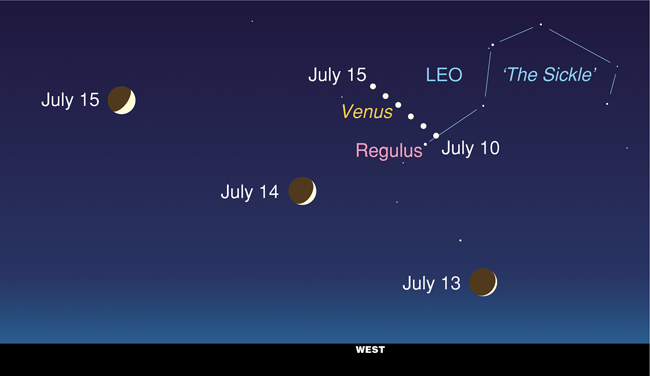5 Celestial Lights to Brighten July's Nights

Fiveof the sky's brightest and most dazzling lights will make appearances in the westernsky on several nights this month in a promising celestial show for skywatcherswith clear skies.
Venus,the dazzling evening star, is currently creeping past Regulus, the brighteststar of Leo, the lion. At the beginning of July, Venus was wellto the lower right of Regulus, but now the planet stands side by side with the brightstar.
Being the brightest object in the night sky other than the moon, Venus isimpossible to miss. People often mistake it for an airplane or UFO, and callsto local police and sheriff departments are not uncommon when Venus graces theevening sky.
?( Thisgraphic shows how to see Venus, Regulus and the slender crescent moon in July.)
Luckyskywatchers can catch Venus and Regulus tonight, Friday July 9, as they swingclosest together, separated only by about one degree ? less than the width of afinger held at arm's length.
Theslim crescent moon will dance close to this bright duo on July 14, making anequilateral triangle with the moon at left, Venus on top, and Regulus on theright.
Theorange-hued planet Mars and the golden gas giant Saturn will be a little higherto the group's upper left. (Use this graphic to spot Saturn and Mars together withthe moon, Venus and Regulus on July 14.)
Breaking space news, the latest updates on rocket launches, skywatching events and more!
Thedisplay of these five brightcosmic objects provides a good look at the ecliptic ? the path that the suntraces across the sky.
Inancient times, the ecliptic was thought to hold special significance. In fact,the first major constellations ever drawn were those of the zodiac ? the 12constellations that lie along the ecliptic.
Yet, celestial events are not solely confined to July nights. On Sunday, the sun will cast a dark shadow over a slice of the Earth's surface in a total eclipse spectacle.
- TheBrightest Stars in the Sky
- Beginner Astrophotography Telescopes
- Gallery- Venus Seen From Around the World

Denise Chow is a former Space.com staff writer who then worked as assistant managing editor at Live Science before moving to NBC News as a science reporter, where she focuses on general science and climate change. She spent two years with Space.com, writing about rocket launches and covering NASA's final three space shuttle missions, before joining the Live Science team in 2013. A Canadian transplant, Denise has a bachelor's degree from the University of Toronto, and a master's degree in journalism from New York University. At NBC News, Denise covers general science and climate change.
